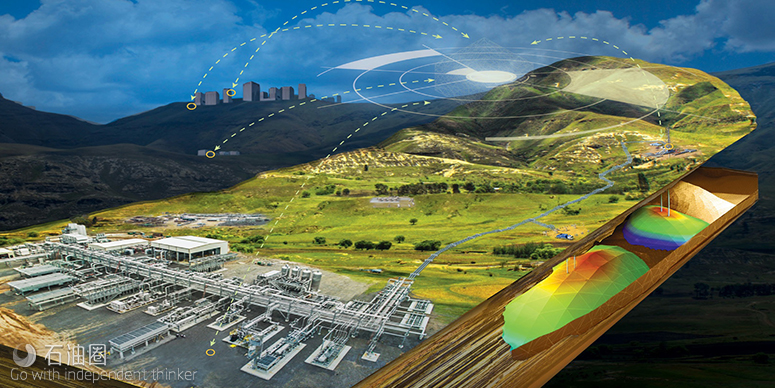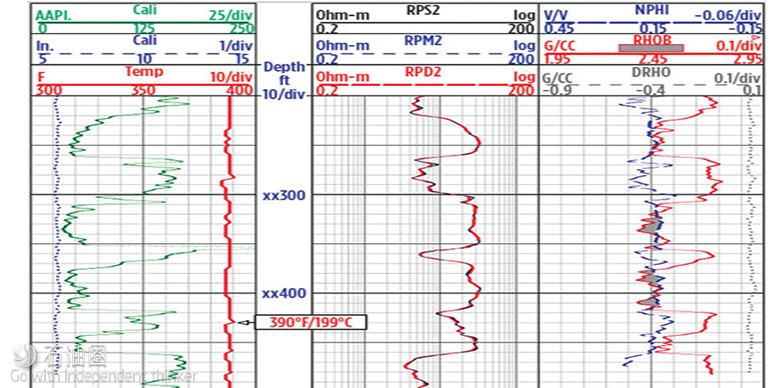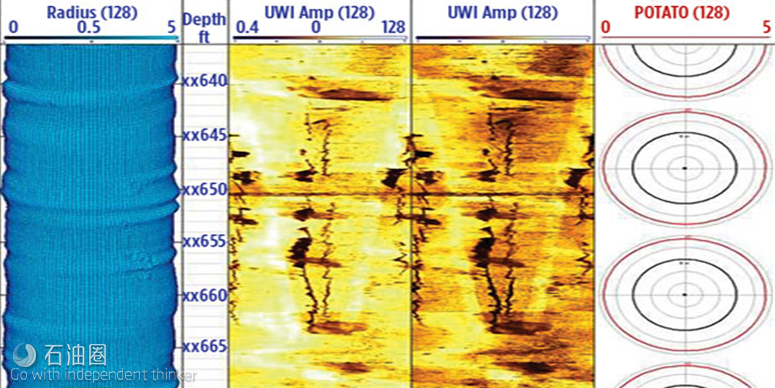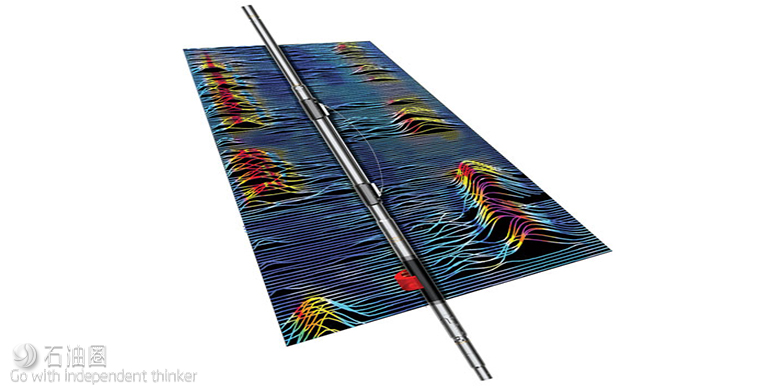Recent advancements in logging-while drilling and wireline logging technology have improved the industry’s ability to place wells in the reservoir, evaluate adjacent formations, and understand targeted reservoirs and the rocks and fluids that comprise them.
Halliburton reports that its EarthStar resistivity LWD service can detect and map reservoir and fluid boundaries located more than 225 ft (68 m) from the wellbore, at least twice the range of previously available systems. The new service combines deep-reading resistivity measurements, azimuthal sensitivity and advanced inversion processing to determine the orientation of formation layers, and the position and resistivity of fluids in them. The service also provides 3D images, which are used in combination with real-time geosteering software to optimize well placement.
The service’s deep reading resistivity can be used to map pockets of hydrocarbons along the wellbore, identifying potentially bypassed pay. This contributes to improved reservoir evaluation and more efficient field development, Halliburton maintains.
The ultra-deep resistivity measurements also enhance real-time steering decisions. Geosteering engineers are alerted if the well is about to leave the reservoir and are warned about potential hazards ahead of the bit, so they can stop drilling before a sidetrack is needed, eliminating pilot holes. With improved LWD measurements, drillers can be more confident in placing wells above the oil/water contact for optimum completion and production.
Halliburton reports that the EarthStar service has been successfully applied in deepwater and mature field applications. In one North Sea well drilling through a carbonate reservoir that had been partially water-flooded, the deep reading logs identified a bypassed productive zone that subsequently contributed to the field’s output, Halliburton said.
GEOSTEERING IN SHALE
Nabors Industries’ Accusteer measurement and LWD system has been applied successfully for geosteering in shale formations in the Permian and other North American basins. Packaged in a 30-ft collar, the 4¾-in. OD Accusteer system acquires a unique combination of measurements that, in addition to directional readings, include azimuthal gamma, continuous inclination, annulus pressure (ECD), shock and vibration, stick-slip, and downhole weight on bit. The larger 6¾-in. tools also can include propagation resistivity sensors. The system uses a switching telemetry scheme that eliminates toolfaces while rotating to maximize bandwidth and log quality.
The system’s 16-sector azimuthal gamma ray measurement (compared to total gamma ray) provides high-resolution image logs that are used to identify formation layers and guide the bottomhole assembly within them. Continuous inclination near the bit and instantaneous dogleg severity calculations provide continual awareness and enhanced control over the wellbore’s trajectory.
Drilling dynamics measurements—unusual in such a small diameter system—are designed to provide real-time data on mud motor operating performance, help prevent sticking, and improve sliding efficiency.
In a West Texas application, the Auccusteer measurements helped the operator drill an 8,125-ft lateral 100% within the target zone in just two days. Azimuthal gamma readings helped maintain the well in a faster-drilling bed for 4,000 ft without sliding to correct inclination.
In Oklahoma, Nabors reports that the azimuthal gamma measurements helped one operator land the wellbore at the right depth and then keep 100% of the 5,200-ft lateral within the target zone.
HIGH TEMPERATURE LWD
Weatherford International recently introduced the HeatWave Extreme (HEX) HPHT LWD system, specifically for deepwater applications, Fig. 1. Rated at 392°F (200°C) and 30,000 psi for up to 200 operating hours, the system includes gamma ray, resistivity, density and neutron, as well as pressure while drilling sensors. Weatherford developed the technology along with a major operator to operate in hostile conditions.
After a nine-month development project, Weatherford deployed the HEX service in 22 high-temperature offshore wells in the Gulf of Thailand, acquiring real-time and recorded data for a total of 1,650 hours, logging 150,282 ft (45,806 m) of hole, with some bottomhole temperatures exceeding 347°F (175°C).
No temperature-mitigation efforts, such as reducing rpm, controlling the rate of penetration, or circulating to cool the BHA were required. The 22 wells were drilled and logged in an average of 6.2 days per well.
ACOUSTIC IMAGING LWD
Weatherford also has introduced a high-resolution wellbore imaging LWD system, called the Ultrawave Ultra-Sonic Imager, which can operate in water- and oil-base mud.
The imager records 360° measurements of the amplitude and travel time of ultrasonic acoustic waves reflected from the borehole wall. The reflected amplitude image reveals bedding, natural fractures, and secondary porosity, induced fractures and borehole breakout. The travel time image produces high-resolution standoff and borehole caliper images to analyze borehole stability. Imaging can be used while drilling to optimize the placement and completion of wellbores in unconventional reservoirs. The system also detects artificial fracture network connectivity to mitigate frac hits in shale wells and to help operators design frac treatments and completions accordingly.
MULTI-FREQUENCY DIELECTRIC
Openhole wireline logging technology continues to become increasingly sophisticated with new measurements being combined with suites of established sensors. The Array Dielectric Xplorer service from Baker Hughes, a GE company (BHGE), is a recent example.
Standard resistivity measurements rely on the conductivity difference between oil and salt water to detect hydrocarbons adjacent to the wellbore. When the formation water is fresh and non-conductive, resistivity logs are not reliable. The new system uses multi-frequency dielectric technology to acquire dielectric permittivity measurements to determine hydrocarbon saturation with any formation water salinity.
A significant advancement over prior dielectric instruments, the Array Dielectric eXplorer uses four 1-in. spaced receivers with three pairs of transmitters placed symmetrically above and below. The electromagnetic propagation transmitters operate at five frequencies from tens of megahertz to one gigahertz, and at multiple depths of investigation. Based on transmitter–receiver combinations, the system has six spacings. Data is acquired at each of these spacings, and for each of the five frequencies, to provide borehole-corrected apparent formation resistivity and permittivity values. Petrophysical deliverables include flushed zone resistivity, water-filled porosity, water salinity, and rock textural parameters.
The system allows for fast logging speeds and is combinable with other BHGE wireline services, like the FLeX mineralogical service and the MReX magnetic resonance service, to provide a full understanding of reservoir minerals and total porosity.
The result of a 2.5-year development project, the Array Dielectric Xplorer service has been successfully introduced in several regions including the Middle East, Africa, and the United States.
MAGNETIC RESONANCE SERVICE
Halliburton advanced wireline nuclear magnetic resonance (NMR) logging technology by introducing its new Xaminer Magnetic Resonance Service (XMR), Fig. 3. Recall that instead of evaluating reservoir rock, NMR detects the fluids in the pore spaces to provide measurements of fluid volume, porosity, and permeability.
Halliburton reports that the Xaminer service provides improved vertical resolution of thin beds and helps evaluate organic shales, carbonates, turbidites, and tight gas reservoirs. It also can detect and quantify gas, condensate, water and heavy-to-light oils in the formation.
The new service acquires eight times more data with less than half the power of traditional NMR sensors. It provides 2D and 3D images and enables analysis by distinguishing moveable fluids from capillary bound and micro-porosity held fluids.
The XMR service acquires data in a single pass and can be combined with other logging sensors for comprehensive formation evaluation. The service also can help operators identify unrecoverable reserves before investing in attempts to develop them. Halliburton reports that XMR logs helped a West Texas operator evaluate a carbonate reservoir, finding unrecoverable oil and salt water zones, saving the cost of production testing.

 石油圈
石油圈



